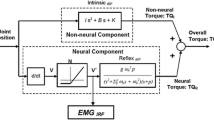Summary
F-wave responses from abductor pollicis brevis muscle occurred more frequently, with a larger amplitude and longer duration in rigid parkinsonian patients than in age-matched normal controls. F-wave potentiation during voluntary contraction was impaired in parkinsonian patients. These findings suggest that spinal motor neuron excitability is enhanced in rigidity. F-wave amplitude was significantly correlated to the clinical evaluation of motor disability, so that the F wave may be regarded as a useful approach to quantitative evaluation of rigidity.
Similar content being viewed by others
References
Berardelli A, Sabra AF, Hallett M (1983) Physiological mechanisms of rigidity in Parkinson's disease. J Neurol Neurosurg Psychiatry 46:45–53
Buchtal F, Schmalbruch H (1970) Contraction times of twitches evoked by H-reflexes. Acta Physiol Scand 80:378–382
Calancie B, Bawa P (1984) Recruitment order of motor units during the stretch reflex in man. Brain Res 292:176–178
Eisen A, Odusote K (1979) Amplitude of the F wave: a potential means of documenting spasticity. Neurology (Minneap) 29:1306–1309
Feasby TE, Brown WF (1974) Variation of motor units size in the human extensor digitorum brevis and thenar muscles. J Neurol Neurosurg Psychiatry 37:916–926
Fisher MA (1980) Relative changes with contraction in the central excitability state of tibialis anterior and calf muscles. J Neurol Neurosurg Psychiatry 43:243–247
Fisher MA (1983) Cross correlation analysis of F response variability and its physiological significance. Electromyogr Clin Neurophysiol 23:329–339
Fisher MA (1983) F response analysis of motor disorders of central origin. J Neurol Sci 62:13–22
Fisher MA, Shahani BT, Young RR (1978) Assessing segmental excitability after acute rostral lesions. I. The F response. Neurology (Minneap) 28:1265–1271
Gassel MM, Wiesendanger M (1965) Recurrent and reflex discharges in plantar muscles of the cat. Acta Physiol Scand 65:138–142
Henneman E, Mendell LM (1981) Functional organization of motoneuron pool and its inputs. In: Brookhart JM, Mountcastle VB, Brooks VB (eds) Handbook of physiology, vol 2. The nervous system. American Physiological Society, Bethesda, pp 423–507
Liberson WT, Chen LY, Fox SK, Patel KK, Yu G, Fried P (1977) H reflexes and F waves in hemiplegics. Electromyogr Clin Neurophysiol 17:247–264
Marsden CD (1982) The mysterious motor function of the basal ganglia: the Robert Wartenberg lecture. Neurology (NY) 32:514–539
Mayer RF, Feldman RG (1967) Observations on the nature of the F-wave in man. Neurology (Minneap) 17:147–156
McLellan DL (1973) Dynamic spindle reflexes and the rigidity of Parkinsonism. J Neurol Neurosurg Psychiatry 36:342–349
McLeod JG, Wray SH (1966) An experimental study of the F-wave in the baboon. J Neurol Neurosurg Psychiatry 29:196–200
Mortimer JA, Webster DD (1979) Evidence for a quantitative association between EMG stretch responses and Parkinsonian rigidity. Brain Res 162:169–173
Potts FA, Shahani BT, Young RR (1981) F response amplitude and its relationship to the motor unit. Neurology (NY) 31:66
Rothwell JC, Obeso JA, Traub MM, Marsden CD (1983) The behaviour of the long-latency stretch reflex in patients with Parkinson's disease. J Neurol Neurosurg Psychiatry 46:35–44
Schiller HH, Stalberg E (1978) F responses studied with single fibre EMG in normal subjects and in spastic patients. J Neurol Neurosurg Psychiatry 41:45–53
Sica REP, McComas AJ, Upton ARM (1971) Impaired potentiation of the H-reflexes in patients with upper motoneurone lesions. J Neurol Neurosurg Psychiatry 34:712–717
Snedecor GW, Cochran WG (1967) Statistical methods. Iowa State University Press, Ames
Tatton WG, Lee RG (1975) Evidence for abnormal long-loop reflexes in rigid parkinsonian patients. Brain Res 100:671–676
Torne J (1965) Central responses to electrical activation of the peripheral nerves supplying the intrinsic hand muscles. J Neurol Neurosurg Psychiatry 28:482–495
Trontelj YV (1973) A study of the F response by single fibre electromyography. In: Desmedt JE (ed) New developments in electromyography and clinical neurophysiology, vol 3. Karger, Basel, pp 318–322
Upton ARM, McComas AJ, Sica REP (1971) Potentiation of late responses evoked in muscles during effort. J Neurol Neurosurg Psychiatry 34:699–711
Yates SK, Brown WF (1979) Characteristics of the F response: a single motor unit study. J Neurol Neurosurg Psychiatry 42:161–170
Author information
Authors and Affiliations
Rights and permissions
About this article
Cite this article
Abbruzzese, G., Vische, M., Ratto, S. et al. Assessment of motor neuron excitability in parkinsonian rigidity by the F wave. J Neurol 232, 246–249 (1985). https://doi.org/10.1007/BF00313788
Received:
Accepted:
Issue Date:
DOI: https://doi.org/10.1007/BF00313788




